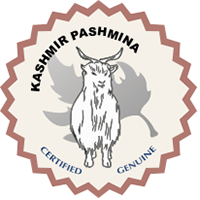
Kashmiri Pashmina : Why is GI tag so important
Share
Kashmiri Pashmina is a luxurious woolen fabric that has been produced in the Kashmir Valley of India for centuries. It is made from the fine undercoat of the Changthangi goat, which is native to the region. The wool is known for its exceptional softness, warmth, and lightness, making it highly prized around the world.
Definition of Geographical Indication (GI)
A Geographical Indication (GI) is a sign used on products that have a specific geographical origin and possess qualities, reputation, or characteristics that are essentially due to that place of origin. A GI tag is a certification that indicates that a particular product is authentic and has been produced in a specific geographical region using traditional methods and materials. It protects the intellectual property rights of producers and helps consumers identify and choose genuine products.
Importance of GI tag for Kashmiri Pashmina

The GI tag is of utmost importance for Kashmiri Pashmina as it protects the authenticity and quality of the product. With the GI tag, the government ensures that only genuine Kashmiri Pashmina products are sold under this name, thus preventing the sale of counterfeit or low-quality imitations. The tag also helps to boost the local economy by promoting the export of the product and increasing the value of the product in the international market. The GI tag also plays an important role in preserving the traditional techniques and craftsmanship involved in the production of Kashmiri Pashmina, thus promoting the sustainable development of the region. Overall, the GI tag adds value to the product, benefiting both the producers and consumers.
Also read: Empowering women through GI Pashmina
What is a GI tag?
A. Definition of GI tag
A Geographical Indication (GI) tag is a certification that is granted to products that are unique to a specific geographic region and have qualities or characteristics that are primarily derived from that region's climate, geography, or traditional production methods. The tag helps consumers identify and choose authentic products and protects the intellectual property rights of producers. It also helps to promote the regional economy and supports the sustainable development of the region.
B. Importance of GI tag
The importance of a GI tag lies in the protection it provides to unique products that are native to a particular region. It prevents the misuse of the product name by unauthorized producers and ensures that only genuine products are sold under that name. The tag also helps to build consumer trust and loyalty by providing a guarantee of authenticity and quality. It is a valuable tool for producers as it helps them to differentiate their product in the market and add value to it. The GI tag also promotes the economic development of the region by creating new employment opportunities and encouraging the growth of the local economy.
C. Benefits of GI tag
The benefits of a GI tag are many. It provides legal protection to the producers of a unique product, preventing its imitation and misuse by others. It helps to promote the product in the domestic and international markets, adding value to it and increasing its visibility. The tag also helps to preserve the traditional knowledge and techniques involved in the production of the product, ensuring their continuity and sustainability. The tag can also provide economic benefits to the region, promoting tourism and creating employment opportunities. Finally, the GI tag can also promote social and cultural benefits by preserving the cultural heritage and traditions associated with the product.
Kashmiri Pashmina
A. History and origin of Kashmiri Pashmina

Kashmiri Pashmina is a traditional woolen fabric that has been produced in the Kashmir Valley of India for centuries. Its origins can be traced back to the 15th century when the Mughal Emperor Akbar introduced the craft to the region. The wool is obtained from the Changthangi goat, which is native to the high-altitude regions of Ladakh and Tibet. The wool is collected in the spring, during the molting season, when the goat sheds its fine undercoat. The wool is then handspun and handwoven into exquisite shawls, scarves, and other accessories.
Also read: Unveiling the Origin of Pashmina Shawl
B. Characteristics and qualities of Kashmiri Pashmina

Kashmiri Pashmina is known for its exceptional softness, warmth, and lightness. The wool is incredibly fine and delicate, with a diameter of only 14-16 microns, making it one of the finest wools in the world. Its unique properties make it highly sought after in the fashion industry, and it is often referred to as the "diamond fiber." The fabric is also incredibly versatile and can be dyed in a range of colors and woven into various patterns and designs.
Also read: What is so special about Pashmina Shawl
C. Economic significance of Kashmiri Pashmina

Kashmiri Pashmina is an important source of income for the people of the Kashmir Valley. The production of the fabric is a labor-intensive process that requires skilled artisans who have been trained in traditional techniques. The industry provides employment opportunities to a large number of people, especially women who work as spinners and weavers. The fabric is also an important export commodity, generating significant revenue for the region. The GI tag for Kashmiri Pashmina has helped to protect the authenticity of the product, increasing its value in the international market and boosting sales. Overall, Kashmiri Pashmina is a valuable asset for the region, providing economic opportunities and promoting sustainable development.
Also read: 30 most frequently asked questions about Cashmere and Pashmina
Importance of GI tag for Kashmiri Pashmina
A. Protection against counterfeit products
The GI tag for Kashmiri Pashmina provides legal protection to the authentic product, preventing its imitation and misuse by counterfeiters. It helps consumers identify and purchase genuine products, ensuring that they receive high-quality and authentic Kashmiri Pashmina. The tag also protects the intellectual property rights of the producers, preventing others from misusing the product name and benefiting from their hard work and craftsmanship.
B. Boost in sales and export
The GI tag has helped to increase the visibility and marketability of Kashmiri Pashmina in both domestic and international markets. The tag serves as a guarantee of authenticity and quality, boosting consumer confidence and leading to increased sales and exports. The tag has also helped to promote the brand value of Kashmiri Pashmina, making it a premium product in the market.
C. Preservation of traditional techniques and craftsmanship

The GI tag has helped to preserve the traditional techniques and craftsmanship involved in the production of Kashmiri Pashmina. The tag has ensured that only genuine Kashmiri Pashmina is sold under that name, preventing the misuse of the name by others who do not adhere to the traditional production methods. This has helped to preserve the cultural heritage and traditions associated with the product, ensuring their continuity and sustainability.
D. Improvement in quality control

The GI tag has led to improved quality control measures in the production of Kashmiri Pashmina. Producers have to adhere to strict standards to ensure that their product meets the criteria for the tag. This has led to better quality products, increasing customer satisfaction and enhancing the reputation of Kashmiri Pashmina in the market.
E. Boost in tourism
The GI tag has helped to boost tourism in the Kashmir Valley. Tourists are attracted to the region to see the production of Kashmiri Pashmina and purchase authentic products. This has led to the creation of new employment opportunities in the region, promoting economic development and sustainability. The tag has also helped to promote the cultural heritage and traditions of the region, attracting visitors interested in learning about the local culture and traditions.
Conclusion
A. Recap of importance of GI tag for Kashmiri Pashmina
In conclusion, the GI tag is incredibly important for Kashmiri Pashmina, providing legal protection, boosting sales and exports, preserving traditional techniques and craftsmanship, improving quality control, and promoting tourism in the region. The tag has helped to protect the authenticity and quality of the product, ensuring that consumers receive genuine and high-quality Kashmiri Pashmina. It has also promoted the cultural heritage and traditions of the region, providing economic opportunities and promoting sustainable development.
B. Implications for other traditional and artisanal products
The success of the GI tag for Kashmiri Pashmina has implications for other traditional and artisanal products. The tag can be used to protect and promote the authenticity and quality of other unique products, preventing their imitation and misuse by counterfeiters. It can also help to preserve traditional techniques and craftsmanship, promoting cultural heritage and sustainable development.
C. Call to action for support and recognition of GI tags for other products
We call for support and recognition of GI tags for other traditional and artisanal products. These products play an important role in promoting cultural heritage and traditions, and the GI tag can help to protect their authenticity and quality. By supporting GI tags, we can promote economic opportunities and sustainable development, preserving the unique identity of these products and the regions that produce them. Let us work together to support and promote the use of GI tags for traditional and artisanal products, ensuring their continued success and sustainability.





